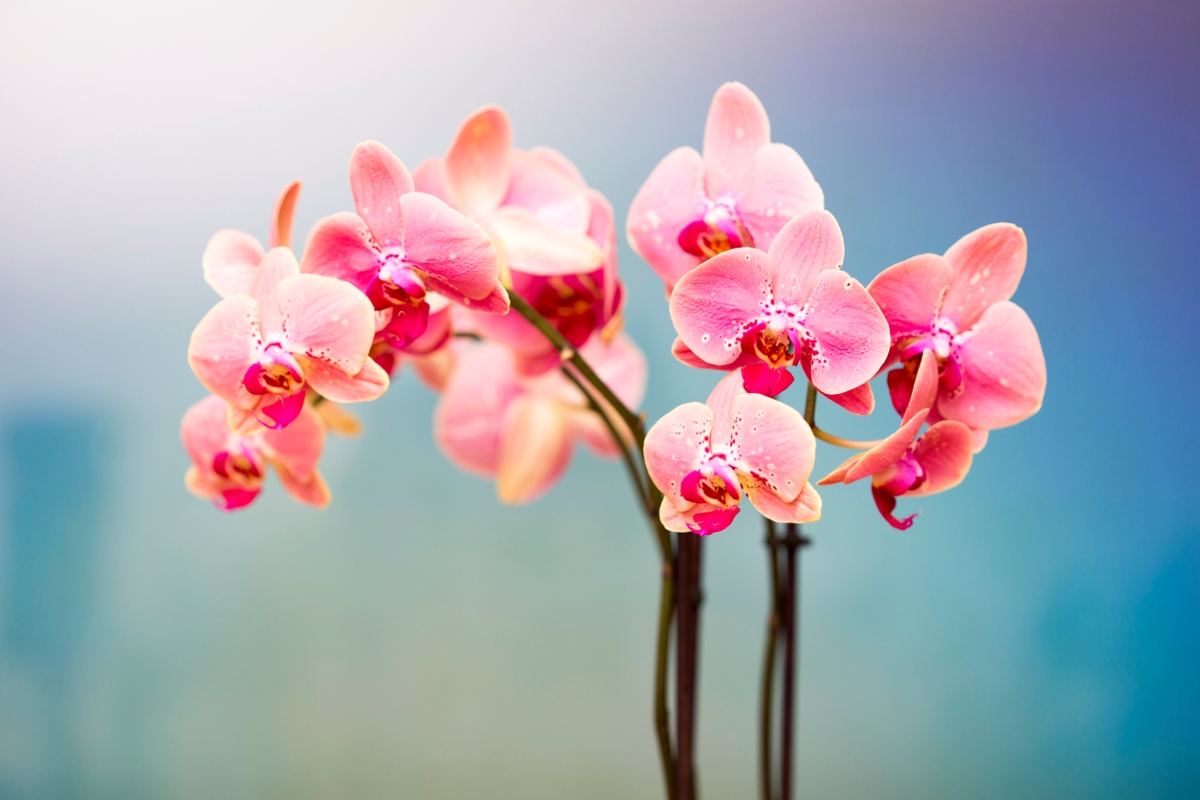

We may earn revenue from the products available on this page and participate in affiliate programs. Learn More ›
If you want to ditch dirty fingernails, you can choose from a wide variety of botanicals that will treat you with gorgeous blooms and greenery using only water—and sometimes just air!—to thrive. From Christmas cacti to orchid varieties and air plants, here are some fun houseplants that don’t need dirt to survive.
1. Orchids (Orchidaceae)

Most tropical orchids are epiphytes, meaning they grow on other plants instead of in soil. But orchids and other epiphytes aren’t parasitic; their roots are covered in a squishy membrane that sucks up water from the atmosphere. Many orchids sold as houseplants come in a planting medium, such as moss or stones, but they will grow just as easily on a piece of bark once their roots take hold.
RELATED: 20 Low-Light Houseplants You Can Grow Practically Anywhere
2. Air Plants (Tillandsias)

Members of the genus Tillandsia, air plants are exactly what they sound like: plants that grow in air instead of soil. More than 650 varieties exist, displaying an immense variety of foliage types and colorful blooms. The leaves of air plants grow in a rosette formation, which helps the plants gather water and nutrients from the environment. When displayed as houseplants, they’re typically placed in decorative dishes or mounted.
RELATED: 12 Plants You Can Grow Successfully in the Shower
3. Spanish Moss (Tillandsia usneoides)

With its drooping, gray-green tendrils, Spanish moss evokes humid summer days and the romance of southern climes. The plant often grows from trees, absorbing water and nutrients from the atmosphere, but with proper care it can also grow indoors. To maintain Spanish moss as a houseplant, mist it with water at least twice a week and fertilize it with high-phosphorus liquid fertilizer every two weeks. Any Spanish moss gathered from the wild will be infested with small insects, so if you want to grow it indoors, purchase plants from a trusted supplier.
RELATED: 6 Indoor Plants That Don’t Need Drainage
4. Marimo Moss Balls (Aegagropila linnaei)

Marimo moss balls, also known as Cladophora balls, are spherical algae. They can be grown in an aquarium with fish, or they can live alone in a jar of water. To maintain marimo moss balls, simply keep them in low indirect sunlight, and change their water every couple of weeks.
RELATED: How To: Grow Moss
5. Paperwhites (Narcissus tazetta)

Paperwhites are a variety of daffodil that can be forced from bulbs indoors during the winter. These fragrant plants will gladly grow in nothing more than water and some pebbles. Thanks to their white and yellow blooms, cheerful paperwhites will buoy you through those cold, gray months.
RELATED: Beyond Poinsettias: 23 Houseplants That Bloom in Winter
6. Aechmea (Aechmea)

A member of the Bromeliad family of tropical plants, aechmea is often sold in decorative containers in nurseries. The plants can grow in a small amount of soil, yet in the wild they’re nonparasitic grapplers, with their roots anchored to a host plant. Aechmea thrives in both light and shade, and it’s not susceptible to many pests. Given their easy care and colorful appearance, it’s no wonder they’re often given as gifts.
RELATED: This Guide to Bromeliad Care Covers Epiphytic and Terrestrial Varieties
7. Christmas Cactus (Schlumbergera bridgesii)

Popular gifts during the holidays, Christmas cacti can grow year-round in a vase of just water. To get them to root, use a sharp, clean knife to cut a Y-shaped piece from the stem tip, ideally with two to three jointed segments. Let the cutting dry for a few hours then place the bottom portion in water and place it somewhere with indirect light. Change the water for Christmas cacti every week or so, and within a few weeks you should see new roots forming.
8. Amaryllis (Hippeastrum)

Amaryllis plants feature showy trumpet-like flowers that can be red, white, orange, or pink. They grow from a bulb and usually bloom in late winter or early spring. When growing this beauty in water, take care not to submerge the bulb because it will rot. Instead, fill a vessel with gravel or decorative stones until it’s about three-quarters full. Trim any dry brown roots from the amaryllis bulb and place it upside down into the gravel, leaving the top third exposed. Then add about an inch of water and place the vessel in a sunny window, changing the water about once per week.
RELATED: 11 Christmas Plants That Will Enliven Your Holiday Decor
9. Baby’s Tears (Soleirolia soleirolii)

Baby’s tears plants, also known as mother of thousands, form a mat of tiny round leaves that makes for a great addition to a terrarium or fairy garden, as well as a standalone plant. You can place a cutting stem in a small jar of water, changing the water weekly, or place it on top of some rocks in a terrarium, adding a little bit of water periodically.
RELATED: The Best Planters
10. Hyacinth (Hyacinthus)

Hyacinths feature stunning spikes of fragrant flowers that come in a variety of hues, including purple, pink, white, and blue. The little star-shaped flowers are a great way to add pops of color to your indoor aesthetic. These stunners grow from bulbs, and do best in water when they’re grown from a dedicated bulb vase. Simply set the bulb in the vase’s neck so that the roots just graze the water, then place the vase in a bright sunny window and enjoy the blooms. If your bulb hasn’t sprouted yet, follow the same process but place the vase in a dark, cool room for about 6 weeks until it sprouts. Then transition it to a bright window.
